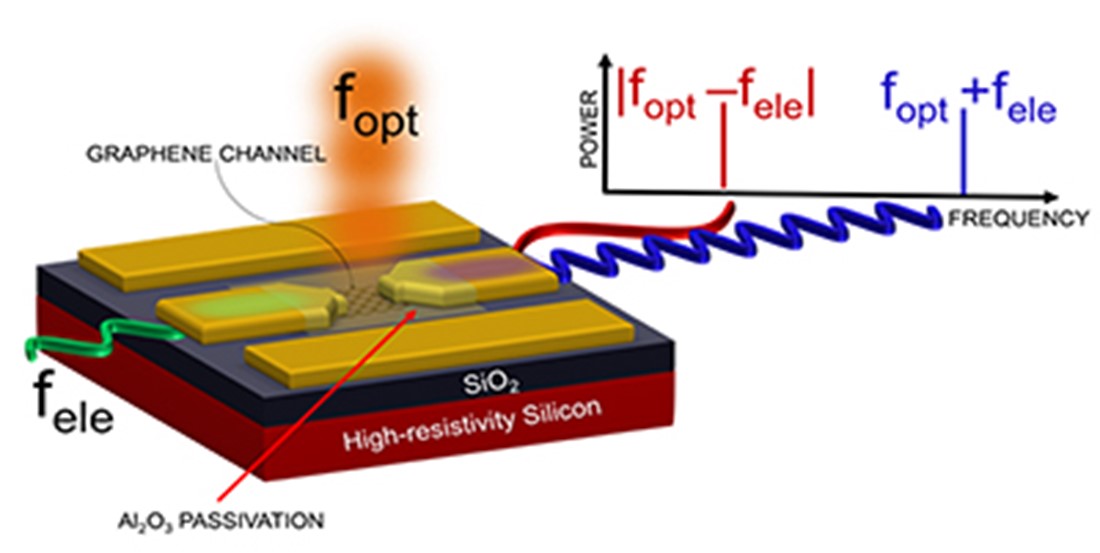High-Frequency Electronics
Work Package 4 (WP4), High Frequency Electronics, focuses on the development of graphene-based electronics technologies operating at gigahertz frequencies and above, capable of significantly outperforming state-of-the-art devices. Work Package leader is Daniel Neumaier of AMO GmbH in Aachen. Deputy leader is Herbert-Zirath from Chalmers University of Technology in Göteborg. Here we highlight two WP4 achievements over the past year.

Radio-frequency shielding
We live in an increasingly noisy electronic world, with mobile and static devices emitting electromagnetic radiation in the radio-frequency range. Shielding sensitive electronics against radio-frequency interference (RFI) and providing electromagnetic compatibility is critical, and this means searching for and optimising materials that serve such a purpose.
Graphene is a material of interest for RFI shielding, owing to its consistently high conductivity over a wide frequency range, typically from 0-100 gigahertz. Researchers with the flagship's high-frequency electronics work package have come up with a graphene solution to microwave interference1, based on the stacking several layers of the 2d material.
Belarus State University physicist Konstantin Batrakov2 and others found that the conductivity of graphene layers adds arithmetically when they are separated by thin polymer layers. Maximum microwave absorption is achieved with six graphene planes separated by layers of the transparent plastic PMMA, also known as acrylic glass. Furthermore, theoretical work3 by Michaël Lobet and colleagues from the University of Namur has demonstrated that the microwave absorption is not adversely affected by unavoidable defects in the graphene structure.
Microwave mixing in electro-optical systems

High-speed communication. whether it be along fibre-optic cables or via wireless transmission, involves carrying the information on signals with frequencies of tens of gigahertz. For practical applications, such signals are on reception shifted down to the megahertz range. This can be done by means of electronic oscillators, in the case of pure electronic systems.
With radio-frequency communication, on the other hand, the downconversion can be done optically, with photodetection of the local oscillator signal, and a transfer to the electrical domain with conventional electronic mixers. A more compact alternative is based on optoelectronic mixers that incorporate photodetection and mixing functions within the same device.
In a soon-to-be-published paper4, Alberto Montanaro of the French electronic systems company Thales and others present a graphene-based device capable of optoelectronic mixing at a frequency of 30 gigahertz. By combining a 30-GHz intensity-modulated optical signal with a 29.9-GHz electrical signal, the flagship researchers achieve frequency downconversion to 100 MHz. The experimental results could lead to advances in optoelectronics for radar and radio-communication systems.
Speaking for the Graphene Flagship, WP4 leader Daniel Neumaier says: "We have made substantial progress in processing graphene and realising graphene-based electronic devices. This allows us to exploit the unique properties of graphene in more complex integrated microwave circuits. The fabrication of high-quality graphene devices such as transistors on cheap, microwave-compatible substrates is an essential step in exploiting frequency bands above 50 GHz, and for applications in consumer electronics."
References
1. Francis Sedgemore, A graphene solution for microwave interference, Graphene Flagship, 30 March 2015.
2. K. Batrakov et al, Flexible transparent graphene/polymer multilayers for efficient electromagnetic field absorption, Scientific Reports 4, 7191 (2014). doi:10.1038/srep07191.
3. Lobet et al., Robust electromagnetic absorption by graphene/polymer heterostructures, Nanotechnology 26, 285702 (2015). doi:10.1088/0957-4484/26/28/285702.
4. Montanaro et al., 30 GHz optoelectronic mixing in CVD graphene, arXiv:1511.02791 (2015).



